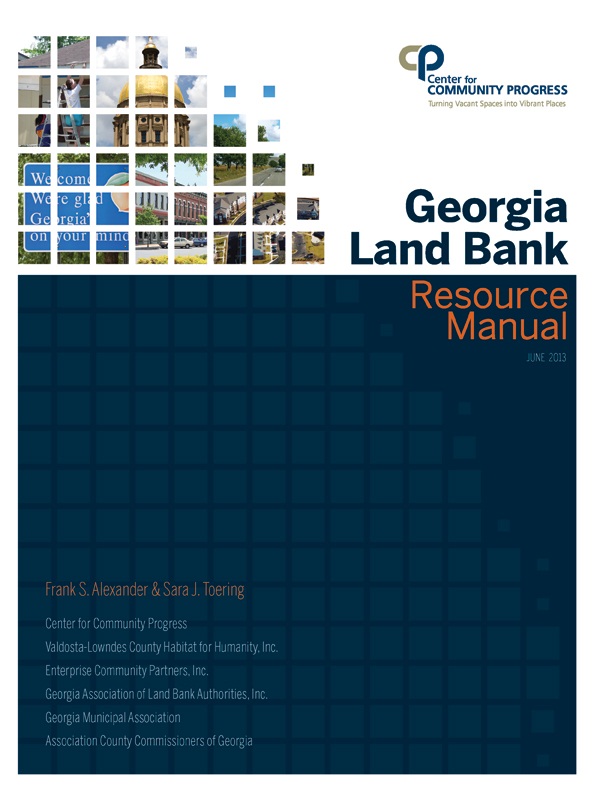New Resource Manual Streamlines Start-Up Process for Georgia Land Bank Authorities (Press Release)
June 25, 2013

 A collaborative of nonprofit organizations, including Center for Community Progress, has released the comprehensive Georgia Land Bank Resource Manual (PDF) to guide stakeholders through the process of creating new – and working with existing – land bank authorities.
A collaborative of nonprofit organizations, including Center for Community Progress, has released the comprehensive Georgia Land Bank Resource Manual (PDF) to guide stakeholders through the process of creating new – and working with existing – land bank authorities.
The Resource Manual is the first of its kind, providing not only background context and a start-up road map but also a full suite of sample legal documents and other operational templates. These templates will help new land banks get off the ground and help existing land banks begin to operate under the new 2012 Georgia Land Bank Act.
While land banking was first authorized in Georgia more than 20 years ago, the passage of the 2012 Georgia Land Bank Act marks an important transition for land banking in the state.
The new law opens the door for regional collaboration through the creation of multi-county land banks. It also expands options for land bank revenue generation to improve financial viability. In addition, the 2012 Georgia Land Bank Act increases flexibility for local land banks to decide upon the best acquisition, maintenance, and reuse strategies for problem properties in their communities.
The Georgia Land Bank Resource Manual includes the history of land banking in Georgia, key statutes, and considerations for land bank operations. The bulk of the Resource Manual, however, consists of legal templates to directly aid implementation, including intergovernmental contracts, administrative policies, a land bank depository agreement, and a tax extinguishment resolution.
 “We’re pleased to offer the Georgia Land Bank Resource Manual,” says Frank Alexander, co-author and Co-Founder of Center for Community Progress. “We hope it streamlines the land bank start-up process and ensures that more vacant properties are returned to productive use, sooner, for the benefit of Georgia’s communities.”
“We’re pleased to offer the Georgia Land Bank Resource Manual,” says Frank Alexander, co-author and Co-Founder of Center for Community Progress. “We hope it streamlines the land bank start-up process and ensures that more vacant properties are returned to productive use, sooner, for the benefit of Georgia’s communities.”
“The Valdosta-Lowndes County Land Bank Authority is one of our strongest partners and has been an important guide in our work to reclaim vacant properties to create homes for Georgia families,” says Stuart Mullis, Executive Director of Valdosta-Lowndes County of Georgia Habitat for Humanity, Inc. “We are thrilled to sponsor a publication that will support stronger and more creative partnerships between new and old Georgia land banks and the non-profit housing organizations in our State.”
Beyond Georgia
The Georgia Land Bank Resource Manual is a model that other states with land bank enabling legislation may wish to explore. In particular, a manual that features sample legal templates, tailored to the State’s specific statutory context, can ease an otherwise burdensome task for local jurisdictions with limited internal capacity.
These templates can help to ensure that a new land bank is not only designed in accordance with legal requirements, but also reflects current best practices in vacant property reclamation.
Authors and Partners
Frank S. Alexander and Sara J. Toering, legal and policy advisors to Center for Community Progress, co-authored the Georgia Land Bank Resource Manual, which is a publication of Valdosta-Lowndes County of Georgia Habitat for Humanity, Inc. (Valdosta Habitat) and the U.S. Department of Housing and Urban Development. The Georgia Association of Land Bank Authorities (GALBA), Enterprise Community Partners, Georgia Municipal Association, Association County Commissioners of Georgia, and the Center for Community Progress are co-sponsors of the publication.
Recent Press Releases
Subscribe to join 14,000 community development leaders getting the latest resources from top experts on vacant property revitalization.
